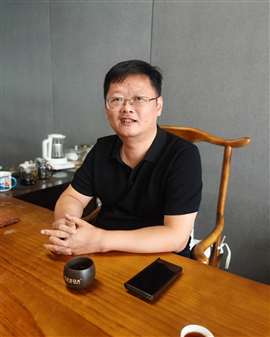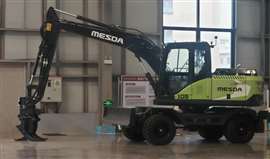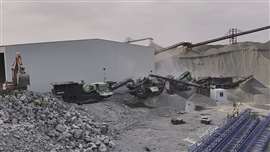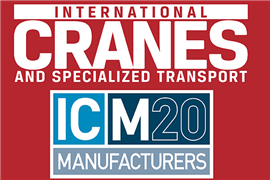Read this article in 中文 Français Deutsch Italiano Português Español
Crushing convention: China’s Mesda eyes a global breakthrough
04 September 2025
Already a leading manufacturer of crushing and screening equipment in its home market of China, Mesda has ambitious plans to expand internationally. Neil Gerrard speaks to Mesda chairman and CEO Mr. Peter Huang.
In the global construction equipment business, few manufacturers are as young or as ambitious as Mesda.
 Peter Huang, chairman and CEO of Mesda
Peter Huang, chairman and CEO of Mesda
Based in Nanning, the capital of Guangxi province near China’s border with Vietnam, the company may not yet be that well known in the western world but has grown rapidly over the past 15 years to become a dominant player in its home market for mobile crushing and screening machinery. Now it has its sights firmly set on international recognition.
For Peter Huang, Mesda Group’s chairman and chief executive, the journey is as much personal as it is professional. A graduate in Chinese literature who taught himself English in just a few years, he has built Mesda not just on its engineering credentials but on a restless fascination with technology and machines, coupled with a strong attachment to his home region. During a conversation with Construction Briefing in Nanning, he flicks through videos and diagrams on his folding Huawei smartphone, using it to underscore his points about market potential and product evolution. The energy is unmistakable: he is youthful, affable, and determined that Mesda should not only be recognised abroad but also one day enter International Construction magazine’s Yellow Table of the world’s largest equipment makers.
The Chinese market
At home, Mr. Huang believes China’s crushing and screening sector is still in its infancy. “I think the Chinese market is only just beginning. Right now in China, there are more than 10 [crushing and screening machinery] brands. They are only for recycling and construction. There are not many machines in mining.”
 A Mesda J11H jaw crusher at the Mesda factory in Nanning, China
A Mesda J11H jaw crusher at the Mesda factory in Nanning, China
That imbalance represents opportunity. The domestic housing market has been weak in recent years, but urban redevelopment is picking up pace. In Nanning alone, plans are under way to demolish pre-2000 housing stock as part of a regeneration programme. Mr. Huang claims that budgets amount to RMB 73 billion (US$10.2 billion) at the national level, topped up with a further RMB 50 billion ($7 billion) in municipal funds – a total of RMB 130–140 billion ($18.2-$19.6 billion). “Nanning being the trial city is the main focus for the whole of China. So if the system becomes successful, then it’ll be carried out nationwide,” he asserts.
Some observers question whether such funds are readily available, given China’s recent economic struggles. Yet Mr. Huang sees the programme as a major opportunity for mobile recycling equipment. “Recycling is just beginning in China. Mobile crushing and screening are important markets in Europe already. But the European market today is the Chinese market tomorrow.”
Construction remains another source of demand. He highlights investment in new highways worth several hundred million RMB, alongside a RMB 150 million ($21 million) service station project between Yuling and Nanning.
Meanwhile, mining offers longer-term potential. Only two global players - Metso and Sandvik - dominate, while Mesda and its compatriots offer equipment at significantly lower cost. “Producing these machines requires a major capital investment,” Mr. Huang notes, pointing out that this acts as a barrier to smaller Chinese entrants who might otherwise crowd the market.
An innovative approach to manufacturing
As demand rises, Mesda is preparing to change how it makes its machines. The company is building a vast new industrial park in Nanning designed to consolidate its operations and transform its production philosophy.
 A digital render of Mesda’s planned industrial park in Nanning, China (Image courtesy of Mesda)
A digital render of Mesda’s planned industrial park in Nanning, China (Image courtesy of Mesda)
At present, Mesda operates five factories, spread across Nanning and nearby cities, each focusing on a particular machine type. The new site, which will cover 400,000 square metres on former industrial land, will instead allow what Mr. Huang calls “island manufacturing.” “You can think about it like this: One island can build an excavator, or a mobile jaw crusher, or a mobile cone crusher. This is the future of factories,” he explains.
The concept is to create flexible production cells capable of switching rapidly between different product lines, reducing the need for stock and ensuring machines are built just days after an order. Existing factories will be repurposed as supplier bases, forming part of a broader ecosystem.
The first phase of the RMB 800 million (US$111.8 million) development is scheduled for completion in July 2026. It is being driven by Nanning’s municipal government, which is financing much of the initial infrastructure. Ownership will remain with the state for the first five to eight years, after which Mesda plans to buy back the park outright.
The ambition extends beyond Mesda alone. In an earlier interview with Construction Briefing’s sister title Demolition & Recycling International, he emphasised a vision of cooperation with other manufacturers - even competitors - to accelerate research and development and share technologies.
Battery technology
Alongside manufacturing change, Mesda is investing in electrification. Mr. Huang outlines a roadmap that divides products by power requirement. For machines below 100kW, Mesda is targeting fully battery-electric drives. Above that threshold, hybrids will take precedence.
 A Mesda wheeled excavator at Mesda’s factory in Nanning, China
A Mesda wheeled excavator at Mesda’s factory in Nanning, China
The company plans to begin with its scalpers, which could be charged overnight when electricity is cheap and deployed for three to four hours during the day. Range-extended electrification (REE) is another option, using a small battery topped up by a generator during peak loads to reduce diesel use. “The ultimate goal is to introduce the battery-powered machines into Europe. But in between we are introducing the REE technology. Ultimately though, battery-powered machines can act as a power bank for the whole site,” he explains.
Certification remains a hurdle. CE marking for the European market is proving complex and time-consuming, delaying the rollout of prototypes. Yet Mr. Huang is convinced the technology will deliver significant cost savings. “The evolution from diesel to battery electric has also shown significant benefits in terms of cost. For example, the 200kwh battery pack actually costs less than an engine from Caterpillar,” he notes.
That matters because engine supply is a weak point. Caterpillar units are in high demand, with delivery times stretching to six months. “We have an efficient manufacturing process to make our machines, but if it takes six months for an engine to arrive then the lead time for the entire machine ends up being six months,” he says. Mesda cooperates with well-regarded domestic engine manufacturers like Weichai and Yuchai, but end users still favour Caterpillar for its familiarity and global service network.
The push for electrification also reflects regulatory pressure. In China, the government is incentivising standardised battery development across both automobiles and construction machines. For Mesda, this could mean lower costs and faster adoption once a common platform is available.
Growth strategy
Mr. Huang’s ambitions extend well beyond China. Europe, North America and the domestic market are expected to account for around three-fifths of revenue in the coming years. South Asia, meanwhile, is already a stronghold and is seen as the next “hot market.” “Nanning is very close to South Asia. It is three hours by air from Beijing, three or four hours to Singapore. It is in the middle of South Asia. So it is very easy to get around the whole market including Vietnam, Thailand, Malaysia and the Philippines. We have a lot of customers in Thailand right now. I think South Asia is the next hot market,” he declares.
 China-based Mesda currently has a 50% share of its domestic market (Image courtesy of Mesda)
China-based Mesda currently has a 50% share of its domestic market (Image courtesy of Mesda)
Africa, South America and Australia are also in the frame, particularly in mining and construction. The company is already active in more than 50 countries and expects to reach 60 shortly. “We are very strong in South Asia and Africa right now. So in future we will focus on the three markets in South Asian construction, mining in Africa, South America and Australia, and recycling in China, Europe and North America.”
Partnerships and acquisitions are part of the plan. Mr. Huang envisages working with established brands overseas, keeping their names for continuity, but supporting them with Mesda’s resources. The company has established a RMB 2 billion ($280 million) capital fund for acquisitions to support this strategy.
The targets are ambitious: annual revenue to rise from just over RMB 1 billion ($140 million) today to RMB 10 billion ($1.4 billion) within five years. That, he hopes, will secure Mesda a place in the Yellow Table’s top 50 OEMs.
Nanning on the map
Nonetheless Mr. Huang is frank about the challenges. Entering developed markets means tackling not just tariffs and certification but also entrenched competition. Yet the ambition is unwavering.
“Nanning is not an industrial city. It is a new city in the south of China. We call it the green city. There are not many manufacturers but in future, everyone will remember Mesda because we were born here, we are growing here and we are strong here.”
 Qingxiu mountain scenic area, Nanning, Guangxi (Image: Weiming via AdobeStock - stock.adobe.com)
Qingxiu mountain scenic area, Nanning, Guangxi (Image: Weiming via AdobeStock - stock.adobe.com)
STAY CONNECTED


Receive the information you need when you need it through our world-leading magazines, newsletters and daily briefings.
CONNECT WITH THE TEAM











